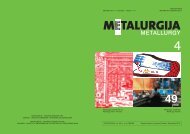pdf - 14652 kB - CARNet
pdf - 14652 kB - CARNet
pdf - 14652 kB - CARNet
You also want an ePaper? Increase the reach of your titles
YUMPU automatically turns print PDFs into web optimized ePapers that Google loves.
S. BockUS: A STUdy of ThE MIcRoSTRUcTURE And MEchAnIcAL pRopERTIES of ...<br />
Antimony helps to form pearlite in cast iron [5]. It is not<br />
expensive, and it is well absorbed by cast iron. Antimony<br />
stops the growth of graphite and austenite crystals, that’s<br />
why crystallizing phases become more dispersed, and<br />
properties of a solidified casting become more even in the<br />
cross-section of the casting. Inoculation with antimony increases<br />
the hardness from 160 - 170 to 180 - 190 hB in the<br />
surface layer of a casting, and from 175 - 185 to 210 - 230<br />
hB in the central section. When antimony content grows in<br />
cast iron, the hardness of a casting increases, more pearlite<br />
appear in cast iron but tensile strength increases only to a<br />
certain limit, which depends on chemical composition of<br />
cast iron and which equals approximately to 0,1 percent,<br />
and then it starts to decrease. When inoculation is made<br />
only with antimony, graphitization of cast iron decreases<br />
a little, therefore, it is better to apply a combined inoculation,<br />
i.e. antimony with a graphitizing one.<br />
290<br />
conclusions<br />
on the basis of presented experimental results and their<br />
discussion, the following conclusions can be drawn:<br />
1. The zone of interdendritic graphite can be decreased<br />
with increasing silicon to carbon ratio and decreasing<br />
solidification rate.<br />
2. Tensile strength and Brinell hardness of continuously<br />
cast ingots increased with increasing Mn, cr, cu, and Sb<br />
additions and decreasing carbon equivalent. however,<br />
Sb increased tensile strength only to a certain limit,<br />
which equals approximately to 0,1 percent, and then<br />
Sb started to decrease it.<br />
3. The microstructural analyses showed that Mn, cr, cu,<br />
and Sb additions increased pearlite content. All these<br />
elements had stronger effect in the surface layers than<br />
in central sections. Antimony helped to unify the microstructure<br />
in the cross-section of the castings. on the<br />
other hand, pearlite content in the structure decreased<br />
with increasing carbon equivalent.<br />
references<br />
[1] L. haenny, G.Zambelli, Engineering fracture Mechanics 19 (1988)<br />
1, 113 - 121.<br />
[2] c. cicutti, R. Boeri, Scripta Materialia 45 (2001), 1455 - 1460.<br />
[3] S. k. das, Bull. Mater. Sci. 24 (2001) 4, 373 - 378.<br />
[4] A. M. Bodiako, E. I. Marukovich, E. B. Ten, choi kiyoung, proceedings,<br />
65th World foundry congress. Gyeongju, korea, 2002,<br />
p. 157 - 166.<br />
[5] S. V. kartoškin, Ju. p. kremnev, L. Ja. kozlov, proceedings, 5th<br />
congress of the Russian founders. Radunica publishers, Moscow,<br />
2001, p. 242-244.<br />
METALURGIJA 45 (2006) 4, 287-290
















